Search results for 'SELECT'
-
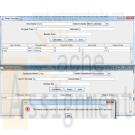
PRG 421 Week 2 GUI Components Program
$20.00PRG 421 Week 2 GUI Components Program
Learn More
For this assignment, you will choose from the following options:
Option 1: Retail Calculator
A retailer would like a calculator to indicate sale prices when he marks items down at various percentages.
Design, implement, test, and debug a GUI application that allows the retailer to enter the item’s name, the item’s original price, and the percentage discounted.
• The application should include a Calculate button that, when pressed, computes and displays the sale price in a label or text field.
• The program should allow the retailer to enter any number of items in this manner.
• Include an Exit button to end the execution of the application.
• The program should allow the user to select a department from a menu. You may create the menu as a true menu, a JComboBox, or radio buttons.
• Create your own list to populate the menu: men’s clothing, women’s clothing, house wares, and so forth.
• Include at least five departments.
• Create a JTextArea or a JTable to display each of the following for each item entered:
o Item name
o Department
o Original price
o Sale price
Option 2: Payroll Application
An employer is looking for an easier way to track employee pay.
Design, implement, test, and debug an application to compute an employee’s weekly pay. If the employee works more than 40 hours a week, the employee earns 1.5 times the basic hourly pay for any time worked over 40 hours. The program should allow the user to input the employee’s name, the number of hours worked, and the hourly rate.
• The application should include a Calculate button that, when pressed, computes and displays the total pay in a label or text field.
• The program should allow the user to enter information for any number of employees in this manner.
• Include an Exit button to end the execution of the application.
• The program should allow the user to select the employee’s department from a menu. This can be a standard menu, radio buttons, or a JComboBox.
• Create your own list to populate the menu: Marketing, IT, Accounting, and so forth.
• Include at least five departments.
• Validate the employee’s hourly wage and hours worked according to the following rules:
The hourly wage must be at least $6 per hour and cannot be more than $150 per hour. It must be numeric.
The hours worked must be a numeric value greater than or equal to 0 and cannot be greater than 60.
• Create a JTextArea, JTable, or other form of a table to your application and use that to list the following for every employee:
o Name
o Department
o Weekly salary
Add each employee to the list after you have computed that employee’s salary. -
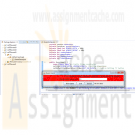
CIS355A iLab 5 GuessGame and Text File I/O Java Programs
$15.00CIS355A iLab 5 GuessGame and Text File I/O Java Programs
In this lab you will create a single program that creates and reads a sequential file. All outputs must be GUI-based without using JOptionPane.
Deliverables
Program files for each of the following two programs
1. GuessGame
2. Text File I/OiLAB STEPS
STEP 1: GuessGame
Write a program named GuessGame.java that plays the game “guess the number” as follows: Your program chooses the number to be guessed by selecting an integer at random in the range 1–1000. The program then displays the following in a label.
I have a number between 1 and 1000 -- can you guess my number?
Please enter your guess: ____________________
A JTextField should be used to input the guess. A JButton must be provided to allow the user to press each time a guess is entered. As each guess is input, the background color should change to either red or blue. Red indicates that the user is getting warmer, and blue indicates that the user is getting colder. A JLabel should display either Too High or Too Low to help the user zero in on the correct answer. When the user gets the correct answer, Correct! should be displayed, and the JTextField used for input should be cleared and changed to be uneditable. Also, a JButton should be provided to allow the user to play the game again. When the New Game JButton is clicked, a new random number should be generated and the input JTextField changed to be editable. A JButton must be provided to allow the user to exit the application. Also provide a count of the number of guesses the user entered when the correct number is guessed.STEP 2: Text File I/O (20 points)
Learn More
Write a program called TextFileIO.java to create a file named numbers.dat. Then create an algorithm that writes all even numbered integers from 1 to 100, separated by a comma. After the file has been created, close and reopen the file and display the results to the screen. After the results have been displayed append the odd number integers from 1 to 100, separated by a comma to the end of the file. Reopen the file and display the results. The contents of the file should be the even numbers from 1 to 100 separated by a comma followed by the odd number from 1 to 100 separated by a comma. The output of this program would be something like the following
2,4,6,8,10,12,14,……,98,100
2,4,6,8,10,12,14,……,98,100,1,3,5,7,9,……..97,99 -
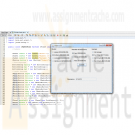
Penn Foster Exam 40254500 Construction Company Java Program
$15.00Penn Foster Exam 40254500 Construction Company Java Program
Write an application for a construction company to handle a customer's order to build a new home. Use separate ButtonGroups to allow the customer to select one of four models, the number of bedrooms, and a garage type. Assume that the models are the Aspen, $100,000; the Brittany, $120,000; the Colonial, $180,000; or the Dartmoor, $250,000. Assume that any model can have two, three, or four bedrooms and that each bedroom adds $10,500 to the base price. Assume that the garage type can be zero-, one-, two-, or three-car, and that each car adds $7,725 to the price. Save the file as JMyNewHome.java.
Learn More -
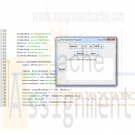
COMP274 Week 6 Programming Assignment The Calendar Program
$25.00COMP274 Week 6 Programming Assignment The Calendar Program
The purpose of this lab is to give you a chance to use some of the data stream tools we have been discussing in a simple application. The assignment is to write a calendar application which allows the user to select a date, and either retrieve a previously stored calendar entry, or save a calendar entry.
Your program should present a GUI interface which allows the user to specify the month, day, and year of the calendar entry. The GUI should also have a text area for displaying and editing a particular entry. It will also need two buttons, one for saving an entry, and the other for retrieving an entry.
Required program elements:
1. Your user interface must allow the user to enter the month, day, and year. You can do this using text fields for input, or you can use ComboBoxes if you feel adventurous.
2. The only GUI components which create events that your program needs to handle are the save and retrieve buttons.
3. Don’t go overboard making your GUI beautiful! We are just looking for basic functionality here!
4. You must have a separate class which manages the calendar data. You will have a minimum of three classes in your application, a user interface class, the calendar manager class, and a calendar test class. The user interface class creates an instance of the calendar manager in its constructor and stores it in a member variable.
5. The calendar manager must provide methods which support saving a specific calendar entry and retrieving a specific calendar entry. The interfaces must be defined to only pass a single day’s calendar entry across the interface.
6. The calendar manager must store calendar data into files according to month+year. That is, the calendar entries for December 2011 must all be stored in the same file.
7. The calendar manager must use ObjectInput/OutputStreams to read/write data from/to files. The calendar manager will use an array to store String objects. The position of a String in this array corresponds to the calendar entry for a specific day.
8. The save method of the calendar manager will need to determine if a file exists for the requested month and year. If so, the object from that file must be read into the calendar manager. Otherwise, the calendar manager must create an empty String array. The new entry must be saved to the appropriate day’s location in the array. The modified array must be saved to the appropriate file.
9. The retrieve method of the calendar manager will need to determine if a file exists for the requested month and year. If not, return an error string indicating that there is no such entry. If the file exists, read the String array from the file and locate the requested day’s entry. If this entry is null, return an error string indicating that there is no such entry, otherwise return the entry.Take screen shots of the output of your program. Paste the screen shots and your source code for your programs into a Word document. Submit your Word document.
Learn More -
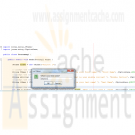
CMIS 141 Project 1 Java Program
$20.00CMIS 141 Project 1 Java Program
This project demonstrates your understanding of datatypes, input/output, sequential and selection programming statements, and mathematical operations.
Before attempting this project, be sure you have completed all of the reading assignments listed in the syllabus to date, participated in the weekly conferences, and thoroughly understand the examples throughout the chapters. The project requirements include:
1. Design and implement a Java program that will gather a user’s first name, middle initial, lastname, age in years, and 3 lucky numbers. The program should output the following based on the user’s input:
a. A welcome message repeating their full name (e.g. Welcome John Q Smith)
b. A message based on their age with these types of messages.
Display “You are just a kid!”, if the user is less than or equal to 12 years old
Display “Welcome teenager!”, if the user is greater than 12 and less than 20 years old
Display “Welcome almost adult!”, if the user is 20 years old.
Display “Welcome adult!” , if the user is 21 years old or greater.
c. A message displaying the average of their 3 lucky numbers. For example “The average of your 3 lucky numbers is : 20”2. Additional requirements include:
1. Use JOptionPane.showInputDialog() methods for your user to input their data
2. Use JOptionPane.showMessageDialog() methods to display your messages.3. Include a comprehensive set of application test data that you used to test your program. Your test data can be shown in a table that includes input data, expected output, actual output and pass/fail results from the test. Your test data can be presented in the form of a table as follows:
Submission requirements:
Learn More
Your deliverables include a Java file and a Word document. The Java file should be named Yournamep1.java. Your word document should include your test table and be named Yournamep1.doc. Your completed assignment should be submitted to your Project 1 assignment area no later than the due date listed in the calendar. -
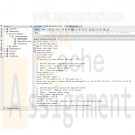
Employee Online Time Clock Project
$25.00Employee Online Time Clock Project
Overview
The final project for this course is the creation of an Online Time Clock. The final project is designed to allow you to put together the concepts learned in the course and to demonstrate your ability to write a useful Java program. The final project is given early in the course so that you will have plenty of time to design the program before it is due.
Early in the course, you will not have the knowledge to implement many of the required elements, but you will still be able to move your project forward by designing it at the conceptual level. Diagramming and pseudo coding before coding a project allows you to think through what needs to be done in detail, thus allowing you to see design flaws before they have been coded. The extra effort to design the program before coding will make the coding process much easier and will result in fewer bugs. The project specifications include a list of requirements that demonstrate different areas of Java development that must be included in your final project to demonstrate your skill in that area. The project shall demonstrate the following skills:
• Use of a static member
• Use of extended class
• Code Commenting
• GUI or Console based interface
• Use of public and private methods
• Use at least one overloaded constructor
• Create instances of class(es)
• Use the 'this' reference
• Optional: Exception handling using try/throw/catch/finallyThe project is divided in to Six Milestones, which will be submitted at various points throughout the course to scaffold learning and ensure quality final submissions. These milestones will be submitted in Modules Four, Six, Seven, Eight, Nine, and Ten.
Main Elements
Approach Blueprint
Coding a project of this size requires some planning and time. Work on building a blueprint for the program throughout the term. Having a blueprint will make the coding simpler and keep you from going down dead ends. Some important things to work on early:
• If the application is using more than one screen (console applications have no choice.), what is the flow between screens? A flow chart that covers all of the possible screen access possibilities will avoid logic problems in the application.
• Break the program down into a set of classes that will work together to execute the program. Object oriented programs are easier to write than structured programs because each class has one set of functionality that it does well and working on one piece at a time makes the programming easier. List out the properties and methods that each class will use so that the relationship between the classes can be established. (Software Engineers create formal class diagrams that show the class hierarchy of a program and how they interrelate. A formal class diagram is not required for this project, but sketching a rough diagram will make things easier.)
• Optional: Error handling can have unexpected results if not done correctly. Diagram how your exception handling will work by sketching a flow chart.
• Validation can be as tricky as error handling, so sketching a diagram is also useful.
• Devise a strategy for handling data. The data may be held in objects in memory, or, optionally, in text files. If you decide to use memory objects, then there should be separate objects for Employee information and their time clock records. The employee memory object (or employee.txt flat file) will be relatively simple since there are no deletes or modifications to an input value. Employees will be employee ID order. The time clock memory object (or timeclock.txt file) is a different story because the records will not be in employee ID order; they will be in the order that an employee punched in or out. When generating a report it will be necessary to find all of the data for each employee and output it in chronological order. The chronological order is already in the memory object (or file) because we are not deleting or modifying any data. The program will only need to group all of the data for an employee together. This can be done in several ways (You may choose which is best, or come up with another solution):
o When an employee punches in or out the program can search the data file and insert the value after the last entry for that employee.
o The system can sort the values in the file in memory as part of the reporting functionality, leaving the data in the file in its original order.Caution is in order because the records should have the punch in time and punch out time for a single day in order. (They will be in that order in the file, because someone has to punch in before they punch out. The program specifications require checking for a 'punched in' record before saving a 'punched out' record.)
NOTE: The separate screen descriptions are for console applications. The GUI application may use one or more screens, as appropriate, but the functionality shall remain the same).
NOTE: Functionality labeled as Optional does not have to be implemented. It is for students who would like to write a more challenging program.
NOTE: Those developing a GUI application will replace the 'input values' with appropriate GUI objects such as buttons. For example, instead of inputting 'A' for Add New Employee, create a button for adding a new employee.Scenario
A company hires you to write a program to track hourly employee arrival and departure times from work. In essence, you are tasked to make an online time clock. The time clock shall keep a history of an employee’s hours for a two-week pay period. The application shall have the following functionality:Main Screen
The main screen shall act as a menu to access program functionality and to exit the program.
The main screen shall:
• Display 4 options
A) Add New Employee – Displays new employee screen
B) Punch In/Out – Displays punch in/out screen
C) Report – Displays report screen
D) Exit – Exits the program
• Display an input field called "Choice" to input one of the four options.
• Inputting an incorrect option shall display a prompt indicating that the input was invalid and to try again.
• Optional functionality: If the user enters an incorrect value more than 3 times, display a prompt that the program is exiting and close the program.Add New Employee Screen
The 'add new employee screen' shall:
• Add a new employee (we will not worry about modifying or deleting.), saving the data to a memory object or file.
o The program shall allow the user to enter the Employee’s First and Last Name
o The program shall validate the first and last name entered to ensure they are not blank. (We will assume that everyone has a first and last name.)
o The program shall assign a new employee ID to the employee and display it on the screen.
o The employee ID shall be generated by adding 1 to the largest employee ID already in the employee memory object (or employee.txt data file).
o The program shall allow the user to enter an unlimited number of employees. In console based applications, the system shall prompt “Do you want to enter another? (y/n). Entering 'y' shall clear the screen and prompt for another employee. If 'n', the program shall return to the main screen.
o The employee data shall be saved to a memory object called employee (or file called employee.txt)
o Optional functionality: Check the first and last name to ensure that there are only valid characters. For examples, filter out numbers, punctuation, etc. Commas can cause problems because the data is being saved to comma-delimited files and that can be a headache!Punch in/out Screen
The 'punch in/out screen' shall:
• Save the punch in or punch out date and time of the employee to a memory object (or file).
o The date and time, 'I' for Punched In or 'O' for punched out along with the Employee ID shall be saved to a memory object called timeclock (or file called timeclock.txt).
o The recorded date for 'punched in' and 'punched out' shall be the method for matching corresponding records.
o The program shall test to ensure that there is a 'Punched in' record for the corresponding day before a 'punched out' record is saved. If none is found, prompt the user to enter a 'punched in' time.
o Then the user has punched in or out, the program shall display a message indicating that the employee has punched in or out, the employee ID, date and time.
o In console based applications the screen shall display "Press any key to continue"
o In console based applications the program shall return to the main menu after a key is pressed when the “Press any key to continue” prompt is displayed.
o Optional functionality: Add the day of the week to the data saved.Report Screen (Hint: If you are writing a console application, java.io.PrintWriter may be useful.)
The 'report screen' shall:
• Allow the user to display a work history report for an individual or for all employees for the two weeks prior to the report request.
o The screen shall display a prompt to enter 'I' for individual employee report, 'A' for all employees report.
o If the selected value is 'I', prompt the user to enter the employee's ID number.
If 'I' is selected the display shall show the employee's name and ID, list out each day worked in chronological order, the number of hours worked that day and a total number of hours worked in the two week period.
The report shall prompt the user to re-enter an employee ID of it does not exist in the employee file.
Optional Functionality: If the user inputs a nonexistent employee ID more than 3 times, prompt the user and then return to the main screen.
o If the selected value is 'A', output the information to the console for the past two weeks.
o The end of the report shall display "Press any key to continue" to return to the main menu.
o Optional Functionality: Allow the user to print the report to a printer.Example Screen Shots
The following screen shots are suggestions for setting up your application. You are not required to make your screens look like these, they are only provided to help you think about the program’s interface. Items that are inside a red box are some example prompts that may not be displayed unless a particular action takes place. You may have more or different prompts depending on how you decide to create your program.
Console Based ApplicationGUI Base Application Using One Screen (You are free to use multiple screens, if desired.)
Learn More -
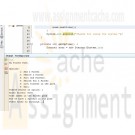
CSC 275 Flower Pack Java Assignment 1
$12.00CSC 275 Flower Pack Java Assignment 1
As I was on a hike the other day I came across a small child in the woods. He told me his life story, with special mention of his disabled sister that loves flowers, and asked me for a favor.
He wanted a way to organize the flowers that he picks for her each day and perform a few basic tasks with them, along with a few restrictions. It is our goal to help him out!
• He can only carry 25 flowers as adding any more causes many of them to become crushed.
• He needs to be able to search for a specific type of flower in his pack incase his sister has a special request.
• He needs to be able to sort flowers by their names alphabetically in ascending order (A-Z)
• He needs to know how many of each flower he has in his pack.Now, I have started a simple program which will serve as guidance for you, please help me finish it. (Please don’t modify the code that I give you, just add your code where required)
Learn More
import java.util.Scanner;
public class Assignment01Driver {
public static void main(String[] args){
new Assignment01Driver ();
}
// This will act as our program switchboard
public Assignment01Driver (){
Scanner input = new Scanner(System.in);
String[] flowerPack = new String[25];
System.out.println("Welcome to my flower pack interface.");
System.out.println("Please select a number from the options below");
System.out.println("");
while(true){
// Give the user a list of their options
System.out.println("1: Add an item to the pack.");
System.out.println("2: Remove an item from the pack.");
System.out.println("3: Sort the contents of the pack.");
System.out.println("4: Search for a flower.");
System.out.println("5: Display the flowers in the pack.");
System.out.println("0: Exit the flower pack interfact.");
// Get the user input
int userChoice = input.nextInt();
switch(userChoice){
case 1:
addFlower(flowerPack);
break;
case 2:
removeFlower(flowerPack);
break;
case 3:
sortFlowers(flowerPack);
break;
case 4:
searchFlowers(flowerPack);
break;
case 5:
displayFlowers(flowerPack);
break;
case 0:
System.out.println("Thank you for using the flower pack interface. See you again soon!");
System.exit(0);
}
}
}
private void addFlower(String flowerPack[]) {
// TODO: Add a flower that is specified by the user
}
private void removeFlower(String flowerPack[]) {
// TODO: Remove a flower that is specified by the user
}
private void sortFlowers(String flowerPack[]) {
// TODO: Sort the flowers in the pack (No need to display them here) - Use Selection or Insertion sorts
// NOTE: Special care is needed when dealing with strings! research the compareTo() method with strings
}
private void searchFlowers(String flowerPack[]) {
// TODO: Search for a user specified flower
}
private void displayFlowers(String flowerPack[]) {
// TODO: Display only the unique flowers along with a count of any duplicates
/*
* For example it should say
* Roses - 7
* Daffodils - 3
* Violets - 5
*/
}
} -
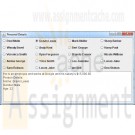
CMIS 242 Final Project Person Details
$15.00CMIS 242 Final Project Person Details
Learn More
This project focuses on demonstrating your understanding of Java Collections. Before attempting this project, be sure you have completed all of the reading assignments listed in the syllabus to date, participated in the weekly conferences, and thoroughly understand the examples throughout the chapters. The project requirements include:
1. Write a Java application that effectively uses Java collections to store up to 20 instances of the Person class and its subclasses. Then write a GUI that displays the Person names using radio buttons to select a name. When selected a TextArea of the GUI should display the information about the selected Person.
2. Your program should compile and run without errors. -
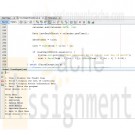
Travel Agents System Java Program
$30.00Travel Agents System Java Program
You are to develop program in Java for a small travel agents. The company arranges holidays from four UK airports to five international destinations. Users need to find flight times and costs for journeys between these destinations. The system also provides information on hotels at the destinations (name of hotel and cost per person per night). Information on hotels can only be added, or loaded from file, when the program is running. The following table (Table 1) provides the airport names, destinations, costs and flight times for the journeys Table 1 Information for the travel agents program – the two values represent cost (£) and flight time (hours) respectively – you can make up your own (realistic values) if you wish
Airport/Destination | New York |Dahab | Rome |Sydney |Tokyo
East Midlands |200/5.0 |150/4.0 |100/1.0 |500/22.0 |400/12.0
Birmingham |190/4.8 |140/3.5 |95/1.1 |480/22.5 |380/12.5
Heathrow |195/4.9 |140/3.6 |95/1.1 |490/23.0 |390/12.5
Manchester |210/5.5 |145/3.7 |110/1.2 |470/22.7 |370/12.6(the above is a data table, where there is a line, represents the cell)
Your program should have a main menu with four options – Time, Price, Hotels and End (which terminates the program). The Hotels option takes the user to another (Hotel) menu with the following six options – View Hotels; Add Hotel; Delete Hotel; Save Hotels; Retrieve Hotels; Exit (back to the previous menu). Note that your program should include appropriate error trapping – for example, entering an invalid date (eg 30 February).
Functionality for each of these menu options is explained below:
Time – Provides the flight time presented in hours.
Price – The cost of travelling from an airport to a given destination (both selected by the user). Note, if the customer is travelling on the last day of the month the fare should be increased by 5% (and display a message to say that this has been done). The system will therefore need to ask the user the date of travel. It should not simply ask the user if it is the end of the month – but work this out from a date provided by the user.
Hotels – Takes the user to a Hotels Information Menu.
Hotels menu
View Hotels – The user selects a destination and the system displays all available hotels at that destination including the overnight cost per person. If there are no hotels for a destination it should display a message to say so.
Add Hotel – Allows the user to add a hotel for a given destination. This should add to the list of existing hotels for that destination (if there are any). For example, I might add 'Belle Vue' as a hotel in Sydney at a cost of £50 per person per night.
Delete Hotel – Allows the user to delete a hotel from a list of hotels at a destination.
Save Hotels – save all the information on all hotels to a single file in a format of your choosing.
Retrieve Hotels – read in all the information on hotels from a user selected file (a file saved using the previous option). This should overwrite any existing hotel data in the program when it is running.Marking
The more functionality you add to the program the higher your mark. Begin by getting the menu options in place then add functionality to your program in the following order (make sure that earlier parts of the system are working properly before moving on). Your program should also be structured in an object oriented way. You should try to identify and implement a number of classes for this program.Minimum pass (40%)
The flight time between any airport and destination;
The cost of travel between any airport and destination;
Increased cost of travel on the last day of the month and a message to say this has been applied;40%-70%
View hotels – users can view information on all hotels at a chosen destination; Add hotel – the ability for users to add hotels for a destination;
Sort hotels – users can sort all hotels alphabetically;Documentation
Learn More
Your coursework should be submitted with appropriate documentation. You should include class diagrams, designs, functionality not completed, functionality working, test plans, evaluation, and program listings. Make sure you include an explanation of how your code should be run (eg. which file should be compiled and run and anything I need to know about using the program – a user guide). -
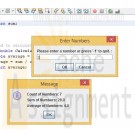
CMIS 141 Project 2
Regular Price: $15.00
Special Price $12.00
CMIS 141 Project 2
This project focuses on the use of of sequential, selective and repetitive programming statements, methods, and modular programming. Before attempting this project, be sure you have completed all of the reading assignments listed in the syllabus to date, participated in the weekly conferences, and thoroughly understand the examples throughout the chapters.
The project requirements include:
1. Design and implement a Java program that will gather a group of floating point numbers and determine the sum and average of the data entered. The program should use separate methods for inputting the data, calculating the sum, calculating the average, and displaying the results. A sentinel value should be used to indicate the user has completed entering their numbers. The output should display a message that includes the count of the numbers entered, the sum of the numbers and the average of the numbers. If the sum of the numbers is greater than 100, a warning message should be displayed indicating "values have exceeded a sum 100".2. Additional requirements include:
1. Use JOptionPane.showInputDialog() methods for your user to input their data
2. Use JOptionPane.showMessageDialog() methods to display your messages.
3. Include a comprehensive set of application test data that you used to test your program. Similar to Project 1, your test data can be shown in a table that includes input data, expected output, actual output and pass/fail results from the test.Submission requirements:
Learn More
Your deliverables include a Java file and a Word document. The Java file should be named Yournamep2.java. Your word document should include your test table and be named Yournamep2.doc. Your completed assignment should be submitted to your Project 2 assignment area no later than the due date listed in the syllabus.




